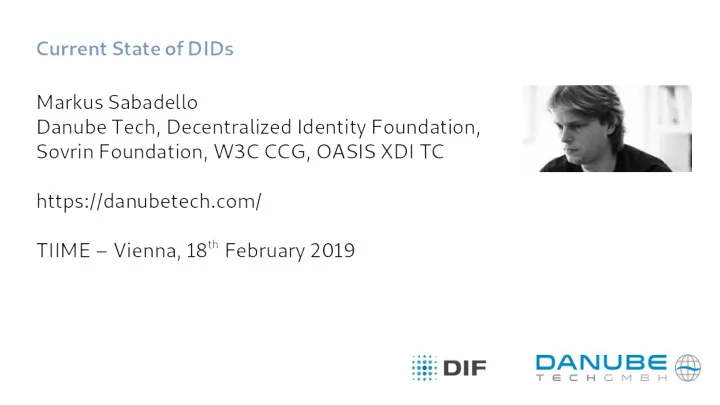

URNs (Uniform Resource Names, RFC 8141) DIDs SSIMeetup.org 2 This presentation is released under a Creative Commons license. (CC BY-SA 4.0).
The four core properties of a DID 1. A permanent (persistent) identifier It never needs to change 2. A resolvable identifier You can look it up to discover metadata 3. A cryptographically-verifiable identifier You can prove control using cryptography 4. A decentralized identifier No centralized registration authority is required SSIMeetup.org 3 This presentation is released under a Creative Commons license. (CC BY-SA 4.0).
A DID Method... Defines how to perform the four CRUD operations on a DID 1. Create: How to generate a new DID 2. Read: How to resolve a DID into a DID document 3. Update: How to write a new version of a DID document 4. De-activate: How to revoke (terminate) a DID so it no longer functions SSIMeetup.org 4 This presentation is released under a Creative Commons license. (CC BY-SA 4.0).
A DID Document... Contains metadata for describing and interacting with the DID subject (the entity identified by the DID) 1. Public keys or other cryptographic proof material 2. Service endpoints for engaging in trusted interactions 3. Authentication mechanisms for proving control of the DID 4. Other metadata SSIMeetup.org 5 This presentation is released under a Creative Commons license. (CC BY-SA 4.0).
DID Resolution... Is the process of using the DID to look up and retrieve a copy of the DID document ● How this is done depends on the DID method ○ Defined by the Read operation ● Different DID methods do this in different ways ● DID Resolution is a separate specification ○ Not in scope for the W3C DID Working Group SSIMeetup.org 6 This presentation is released under a Creative Commons license. (CC BY-SA 4.0).
Comparing DIDs with Domain Names Decentralized Identifiers (DIDs) Domain Names Globally unique Globally unique Persistent Reassignable Machine-friendly identifiers (i.e., long character Human-readable names strings based on random numbers / cryptography) Resolvable using different mechanisms defined by Resolvable using the standard DNS protocol the applicable DID method Associated data is expressed in DID documents Associated data is expressed in DNS zone files Fully decentralized namespaces without delegation Hierarchical, delegatable namespaces based on centralized root registries for top-level domain names (TLDs) Cryptographically-verifiable Verifiable using DNS security extensions (DNSSEC) Fully under the control of the DID controller Ultimately controlled by ICANN and the registry operator for each DNS TLD SSIMeetup.org Released under a Creative Commons license. (CC BY-SA 4.0).
Comparison with other persistent identifiers SSIMeetup.org Released under a Creative Commons license. (CC BY-SA 4.0).
● DID Auth ● OIDC SIOP ● Verifiable Credentials ● DIDComm ● Agents ● Identity Hubs ● Encrypted Data Vaults ● ...
Amsterdam F2F Topics ● Major technical topics: ○ DID Document representations ○ Extensibility and interoperability ○ Metadata ○ Matrix parameters ● Additional topics: ○ Security, IoT, spec structure, rubric, use cases ○ Overlap with DID Resolution SSIMeetup.org 10 This presentation is released under a Creative Commons license. (CC BY-SA 4.0).
Thank you Markus Sabadello Danube Tech https://danubetech.com/ markus@danubetech.com W3C DID WG: https://www.w3.org/2019/did-wg/
Recommend
More recommend